The MORRIS AIMING TUBE
and the .297/.230 Morris Cartridge
See also: ......Miniature calibre adapters and conversions ...... - ......Morris sight adaptor
The Aiming Tube - Morris .297/.230 centre-fire calibre
One of Richard Morris's earliest patent applications was made in 1881, as shown below.
1773 Morris, R. April 25. 1881

Adapting for miniature - ammunition practice ; barrels ; converting .— An ordinary rifle is provided with a longitudinally perforated block B, about the size and shape of an ordinary cartridge, -which is inserted into the breech. A flanged tube D is placed in the muzzle of the gun, and a small tube E is passed through the tube D and screwed at its inner end into the block D. A nut G on the front end of the tube E is screwed up so as to bear against the flange D and keep the parts in position. The barrel of the gun is thus converted into one of very small bore, and small ball cartridges are used which fit the hole in the block B. A sliding piece I in the side of the block moves with the ordinary extractor H and extracts the small cartridge. The inner edge of the piece I passes under the rim of the small cartridge C, while its outer edge passes in front of the extractor H or the slide may be formed to surround the block. The slide may be dispensed with, and the base of the small cartridge provided with a disc of the same size as the base of the ordinary cartridge used with the gun. When the small cartridges are fired by percussion at their edges, the hole in the block B, and the lining- tube E are made eccentric to the bore of the gun so as to bring the edge of the small cartridge in line with the striker. The above contrivance may also be applied for converting a gun of large and smooth bore, such as a fowling-piece, into a rifle. The inner barrel E is made of two lengths, ofwhich the rear part E1 may be of copper, while the front part E only is of steel. The tube F has a smooth bore, and the diameter of the tube El at the bottom of the rifling grooves is the same as that of the tube E. The joint of the two tubes may be formed by screwing, soldering or brazing, and the rifle lands of the tube El die away to nothing at. the joint, so that the bullet takes the rifling gradually as it passes the joint. The joint is covered by a sleeve soldered on, the outer diameter of which fits the bore of the rifle.
Morris was not the only one working on such a device at that time, as another application for equivalent equipment had been made by one H. Pieper only four days earlier.
2O43. Pieper, H. - April 21 1883 [Provisional protection only.]
Adapting for miniature - ammunition practice barrels.— A small rifled practice tube for insertion in the barrel of a rifle is secured or riveted centrally in a plate forming the outer end of a steel or other tubular piece for fitting over the muzzle of the gun. The tubular piece is provided with a slot in which the fore-sight enters and with a ring similar to a bayonet ring so that the tubular piece is secured, when in position, by turning the ring. A brass or copper piece having a flange for bearing against the muzzle of the gun is placed in the barrel so as to support the outer end of the rifled tube centrally in the barrel. The rifled tube carries at its end a sliding steel piece, which forms part of the chamber for containing the practice cartridge and fits in the cartridge chamber of the rifle. A pin on the steel piece engages in a slot in the rifled tube consisting of two longitudinal slots connected by a transverse slot so that the tube can be secured to the steel piece, the pin passing along the lateral slot when the ring on the tubular piece is turned to secure it. When the breech is opened, the extractor of the rifle withdraws the steel piece containing the practice cartridge, which is thereby thrown out of the gun. In order to adapt practice tubes to revolvers and to magazine guns, the steel tubes are shaped like the cartridges normally used, and are chambered and rifled, the tubes being fitted in the chambers of the revolver or in the magazine of the rifle. The used cartridges are pushed out by a small rod after firing.
There are advertisements and references to be found for the early use of the Morris Tube in the Snider conversions (the first British breech-loading service rifle to be introduced), and of the Pattern '53 (1853) Enfield rifled musket, itself the first generally issued rifled (muzzle-loading) British service long-arm; but its most common employment was with the Martini-Henry rifle.
The War Department's "List of Changes in British War Material" (LoC - 4452) shows the date of approval for introduction of the first 'aiming tube' - for the Martini-Henry .577/450 rifle - as 14th. November 1883. The patent for the device was that applied for by the inventor on the 25th. of April 1881; the aforementioned application no. 1773. However, by then the equipment had already found its way to the other side of the World.
A Report in a May 1883 edition of the antipodean Argus newspaper read
" THE MORRIS TUBE. An interesting trial of the Morris tubes, introduced to the colony by Major Sargood, took place yesterday afternoon in the old Government Printing office. One of the rooms in that building has been fitted up as a shooting gallery with fixed targets at the one end and moveable targets at the other and the floor has been marked off in distances of 10, 15, and 25 yards. The targets are so constructed that they can be fired at from any of the distances with the sights set for any range between 200 and 1,000 yards. As has been before explained, the Morris tube converts the Martini-Henry rifle into a weapon which fires a tiny cartridge and bullet. The rifle can thus be used for practice purposes in any fairly sized room or yard, and the only difference between this and practising at the butts is that no allowance has to be made for windage, and the rifle does not kick with the explosion. The loading, sighting aiming aud pulling on the trigger are the same in both cases. Mr Colley, the Government amourer was in attendance yesterday, and explained very clearly how the tubes are fitted into the Martini-Henry. He did this first by means of a half section of a Martini Henry barrel, and then with an ordinary rifle. The tube consists of two parts, viz the chamber and the barrel. The latter is rifled half way up, and this amount of grooving gives all the spin to the bullet that is required for accuracy of aim. The chamber portion is first put in at the butt end of the rifle barrel and held there firmly by a special appliance, The main portion of the tube is then inserted at tbe muzzle, pushed home and screwed into its chamber, after which it is fixed rigidly by means of a check nut. The tube does not fit into the grooving of the rifle, but is held in position by two brass bands which encircle it and which are equal to the riflle's bore. Amongst the gentlemen who took part in yesterday's practice were Majors Shakespear, Douche, and Blannin, Captain Martin, Captain Draper, and several junior officers of the local forces. "
In the 1883 List of changes the equipment was officially described as
" Tube, Aiming, Morris's, Martini-Henry Rifle, (Mark I) "
The Morris Tube for the later Martini carbines came just over two years later.
When the Martini-Henry rifles were converted to .303CF (Centre Fire), initially with Metford rifled barrels and latterly with Enfield rifling, aiming tubes were introduced for the adaptation of those full-bore rifles to the Morris .297/230 miniature cartridge for training purposes. These tubes were necessarily thin-walled compared with the original aiming tube for the .450 Henry barrel.
Below are images of a Martini Metford Carbine adapted for use with a .297"/230" Morris miniature cartridge.

Originally an 1874 Enfield manufactured Martini Henry Carbine II, its markings show it to have been converted initially to a Martini Metford Carbine .303" III in 1893. Unlike the later .22" Aiming Tube for the S.M.L.E., which is in one piece and slides into the bore from the rear with the bolt removed, this is not possible with the Martini action. Instead, the unit is made in two pieces. The rifled tube is fitted from the muzzle, and the chamber section shown above is fitted via the receiver. A locking tool is used to hold the Morris chamber and prevent it from turning whilst the rifled tube is screwed into it from the muzzle. The larger brass locking nut is then screwed up to the muzzle crown with a leather washer in between.

The carbine's final conversion markings
of "MT" on the knox-form
and on the RHS of the butt stock are
illustrated below.

The following images illustrate the Long and the Short of the Morris cartridge, so to speak.
 ..........
..........
The rifle shown is chambered for the Long cartridge.
The flanged sliding extractor of the Morris chamber is pulled back by the original full-bore extractor as if it were a .303" cartridge.
See more on the Martini Metford MT carbine and the Morris Aiming Tube
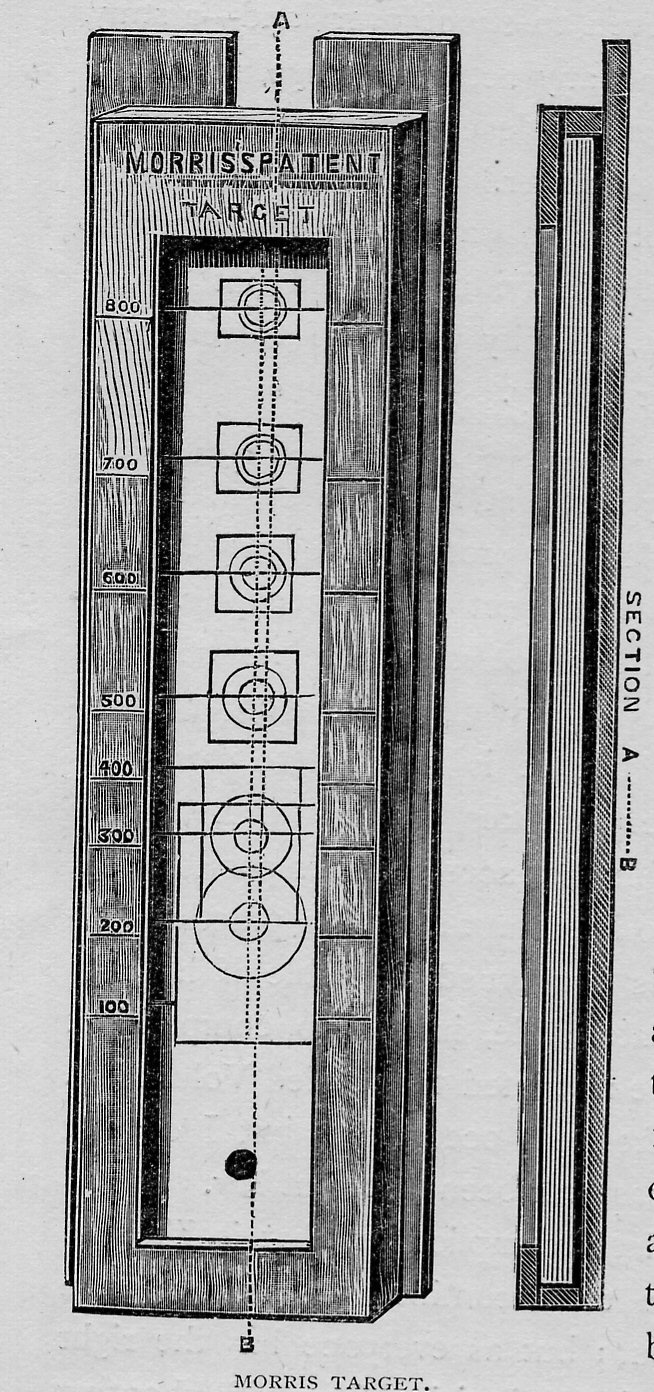 The
use of these "Morris tubes" was continued when the bolt-action Lee-Metford
and subsequently Lee-Enfield rifles were brought into service.
The
use of these "Morris tubes" was continued when the bolt-action Lee-Metford
and subsequently Lee-Enfield rifles were brought into service.
The first such aiming tube was introduced for the "Long" Lee-Metford late in 1891.
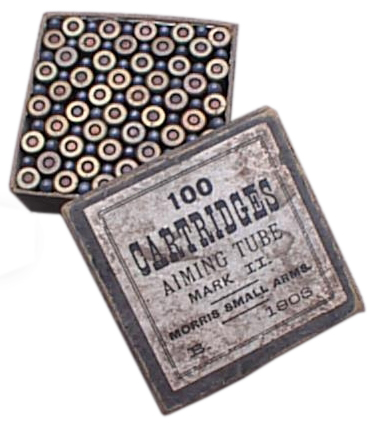
The "Morris Patent Tube Company" as well as manufacturing the aiming tubes and ammunition, are today less known for their marketing, around the start of the twentieth century, of an associated target system - the Morris Patent target. This device was a vertically orientated target box of several feet in height. The patented TARGETS fitted within and were printed vertically onto a tall sheet to represent ranges from 100 yards at the bottom to 800 yards at the top, with a circular aiming or zeroing black mark at the very base. Targets were available for an amazing number of short ranges - for 5, 10, 15 and 25 yards and this with a 40-odd grain bullet in a blackpowder centre-fire cartridge. Whether the target arrangement was still either present or visible, after a good number of rounds had been fired, is a matter for conjecture! Indoor use would be interesting to say the least!
See also: Miniature Calibre Cartridges
In 1887, the British Army's Musketry Regulations carried a section dictating the use of "Miniature" Ranges, Rifles with Morris Tubes and their ammunition.
We illustrate the section as a searchable flip book.
The Morris Tube system was, early in its days, introduced as an artillery sub-calibre device, and was widely used by the Royal Navy.
An engraving in The Graphic illustrated magazine of 20th.May 1888 showed the system in action on the warship HMS Edinburgh whilst it was visiting the Mediterranean island of Malta.
The short range target can be seen slung between two long poles extending outboard, with the capability of lateral movement for the gun-crew's traversing practice.

Interestingly, at the time, the then Duke of Edinburgh was on board during a visit, and was given an opportunity to shoot a rifle on a gallery temporarily set up in what appears to be a main deck level compartment.
At such a short range, it is almost certain that another Morris tube was being employed.

Morris did not rest on his laurels, and continued to develop his ideas; but seemingly not without competition.
His next patent application was made in March of 1889, for a short cartridge that fitted into a kind of conveyor, preceding the Great War "303 cum 22" system of Alfred Parker by more than twenty years.
4039. Morris, R. – March 7 1889
Adapting for miniature ammunition practice. — A short cartridge E is employed,
the space left in the gun chamber being filled up by the tube A.
The projectile B and the mouth D of the cartridge cases are coned
to suit a similar rear formation of the filling-tube A.

Morris followed this up at the end of that month with a modification of his first application of 1881, in which he described a muzzle sleeve that locked over the fore-sight to locate the tube, and a cartridge-case-like breech-block holding an integral auxiliary striker.
5485. Morris, R. March 30 1889

Adapting for miniature ammunition practice.—Relates to tubes such as are described in Specification No, 1773 A.D.1881 The bore of the gun receives the liners B, E which carry the tube A. This tube is attached to the gun barrel by a sleeve which fits over the muzzle, and carries a bayonet-joint rig F to engage behind the foresight of the gun, A breech-block K is made to fit the chamber of the gun, and carries an extractor H. to engage with the miniature cartridge G. The breech-block K carries a firing-pin L which is operated by the firing-pin of the gun as described in Specification No. 13,206, A.D. 1885, with respect to the application of the tubes to ordnance.
As will be seen, this design was utilised with the first of the "Long" Lee-Metford/Enfield magazine rifles.
Whether the Mr. H. Andrews mentioned below was a a colleague or competitor is uncertain, but he was certainly experimenting on similar lines, making this application only two months later, for a remarkably similar cartridge system.
7927. Andrews, H. - May 13 1889
Adapting for miniature ammunition practice.— A is the ordinary service cartridge case, or other similar tube, into which the miniature cartridge B is passed from the rear and held in position by the block C.

The block C is held in position by the split ring G, and the play of the firing-pin D is restricted by the screw E. The head F may be solid with the firing-pin, or made detachable, as shown in Fig. 1,
Almost a year later, Morris made a further application for a sliding breech-block arrangement, which faced up to a centre-fire round that was of the similar design to his short .297/.230 cartridge.
7076. Morris, R. - May 7 1890

Breech actions, sliding breechblock; adapting for miniature ammunition practice.— A horizontal section through the bolt of a bolt-gun is shown, with the cartridge A attached. The usual external base flange on the cartridge is replaced by an internal flange a, which engages with two spring extractors C on the bolt. As the bolt is retracted it draws back the cartridge case, until the extractors are pressed by the sides of the standing breech, when the cartridge is ejected. A modification is described, showing the application of the invention to miniature ammunition.
Around five months after that, Messrs. Andrews & O'Kelly applied with yet another conveyor system, into which a special small rimless low power cartridge was fitted.
This document referred to an application Andrews had made in 1887
for an earlier design of frankly very agricultural appearance,
and the rather more sophisticated version of 1889 that we have already illustrated, and another quite similar one to 15,282 below, being No. 5456 of 10th. April, six months earlier in this same year.
Evidently, every possible avenue was being explored by each of these inventors, in order to exploit what could potentially be a highly profitable enterprise.
15,282. Andrews, R., and O'Kelly, J. Sept. 26 1890
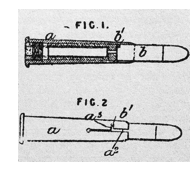 Adapting for miniature ammunition practice - Relates to miniature cartridges and apparatus for use therewith of the kinds described in Specifications No. 14,916, A.D. 1887, No. 7927 A.D. 1889, and No. 5457, A.D. 1890. The chamber of the gun is filled by the block a which carries the small cartridge b. This cartridge is flangeless, but has one or more projections b', which enter slots a2 a3 and connect the cartridge to the block a by a bayonet-joint.
Adapting for miniature ammunition practice - Relates to miniature cartridges and apparatus for use therewith of the kinds described in Specifications No. 14,916, A.D. 1887, No. 7927 A.D. 1889, and No. 5457, A.D. 1890. The chamber of the gun is filled by the block a which carries the small cartridge b. This cartridge is flangeless, but has one or more projections b', which enter slots a2 a3 and connect the cartridge to the block a by a bayonet-joint.
A set of directions was published in various sales catalogues for the use of the Morris Patent Aiming Tubes for Martini-Enfield rifles and carbines.

The text reads -
"The tube consists of 5 parts, viz. : - A. (the breech piece); B. (the tube); C. (the fixed nut at the muzzle of the tube);
D. (the set nut); E. (the leather washer); F. (the brass washer). The leather washer is placed betwen the set nut D at the muzzle of the tube and the brass washer F.
DIRECTIONS FOR USE
1. Take care that the bore of the rifle is clean, as the tube will not enter a dirty or rusty barrel.
2. Screw back the set nut D as far as it will go, and carefully insert the tube down the muzzle of the rifle (precisely in the manner shown at Fig. 2). Place the breech piece frimly in position in the chamber of the rifle by means of the key, screw the tube COMPLETELY HOME into the breech piece as shown in Fig 3. The set nut D should then be screwed down tightly on to the leather washer with the finger and thumb, and care should be taken that it does not work loose, as the shooting is affected thereby. The leather washer E should prevent the set nut from working loose.
3. The extractor on the breech piece of the tube must be pushed back into its proper position before loading or closing the breech of the rifle."
A contemporary advertisement for the equipment prices the tube set, including the key (nowadays rarely to be found), and with a half-dozen suitable targets, at fifty-one shillings,
the equivalent of two pounds and fifty-odd pence in 21st, century terms.
Such equipment, if available, would probably now cost many tens of pounds.

It should be noticed that the advertisment also offers "point blank" fore-sight sleeve adapters for short range work.
Your worn Martini could have a brand new barrel fitted and test fired, to give guaranteed accuracy, for three pounds!
In 1898, the Army's Musketry Regulations carried just a 3 page section on "Miniature Cartridge Practice".
The section is shown below as a searchable flip leaflet.
The upcoming Morris tube for the magazine-fed rifle was not initially designed with the configuration in which it is nowadays best known,
i.e., with the barrel tube screwed into the separate miniature calibre chamber section,
and requiring only a bolt-head change if rimfire ammunition is to be used (as an "Aiming Tube")
It was at first a system to which the much later ".303 cum .22" conveyor cartridge arrangement, introduced by the A.G. Parker company during the First World War, bears some notable resemblance.
However, the Parker design was a full conversion of a parent arm,
with the .303 barrel fitted with a permanent .22 sleeve,
meaning that the service rifle could not be returned to its original configuration.
See: the Lee-Enfield Pattern '18.
To illustrate Morris's early ideas for the repeating rifle, we put forward an article which was published after the introduction of the Lee-Metford magazine rifle, and the text is replicated underneath for clarity.

"We give here an illustration of Mr. Richard Morris's equipment for firing miniature ammunition with the new .303 bore Service magazine rifle. This invention has been in use some years, it was first applied to artillery in 1885, and afterwards adapted to magazine rifles [although previously to the Martini single-shot rifles :Ed], and was publicly exhibited at Wimbledon in 1887, at Mr. Morris's range there, with the Lee magazine rifle. Mr Morris wanted to show his improved magazine for rifles, and, as he could not get enough full-size cartridges, he had to exhibit the magazine rifle using miniature ammunition. The tube was then inserted from the muzzle and held firm by a bayonet catch, and the dummy cartridge holders fed up from the magazine. Since then, Mr. Morris has made an improved tube, which is inserted from the breech as illustrated:-
Figure 1 shows the new Government magazine rifle fitted with a Morris tube, which is inserted into the rifle from the breech, and in which is used the Morris ammunition, exactly the same as in general use. Figure 2 shows the latest pattern of Morris tube for the the .303 rifle, separately fitted with a new extractor suitable for bolt rifles ejecting the ordinary Morris ammunition. Figure 3 shows the dummy cartridge, or cartridge holder with subsidiary striker for feeding up the miniature ammunition from the magazine.
We understand that this tube makes very accurate practice, and the dummy cartridge holder used has the great advantage of being capable of firing a bullet of the full calibre of the rifle without the use of the tube, should such a plan be hereafter decided upon. The use of the tube has this very important advantage, it does not necessitate a change of ammunition, as it takes the ordinary Morris cartridge, as used in the Martini-Henry rifle tube."
In 1899 Morris made a patent application for an updated design of the artillery system earlier mentioned as being in Naval use.
We have obtained, from the archives of the Royal Armouries, extracts from the Small Arms Committee's minutes of 1906 and 1907 that relate to the discussions on the introduction of the Morris tube and Morris Short and Long ammunition, including chambering difficulties with these and .22 Rimfire aiming tubes for the Short Magazine Lee-Enfield Rifle; these being compared with several popular small-bore rifles of the day.
The minutes cover the comparisons in performance, including accuracy and practicality, made between the various rounds, and the suitability of the various cartridges in trials with those different rifles, comprising examples from the Birmingham Small Arms Company, W.W. Greener, the London Small Arms Company, Stevens, Winchester, the .22RF conversion of the Lee-Enfield rifle, and the War Office 1906 Pattern Miniature rifle only just introduced.
Indeed, some of the tubes being trialled were rifled with the same Metford-like curved cross-section grooves as the War Office Miniature rifle.
Below is a searchable flip-page facsimile of the documents, may take a few moments to display. N.B. The search magnifier may need to be clicked twice.
The following piece was published shortly after the introduction of the Lee-Metford magazine rifle.

"We give here an illustration of Mr. Richard Morris's equipment for firing miniature ammunition with the new .303 bore Servive magazine rifle. This invention has been in use some years, it was first applied to artillery in 1885, and afterwards adapted to magazine rifles [although previously to the Martini single-shot rifles :Ed], and was publicly exhibited at Wimbledon in 1887, at Mr. Morris's range there, with the Lee magazine rifle. Mr Morris wanted to show his improved magazine for rifles, and, as he could not get enough full-size cartridges, he had to exhibit the magazine rifle using miniature ammunition. The tube was then inserted from the muzzle and held firm by a bayonet catch, and the dummy cartridge holders fed up from the magazine. Since then, Mr. Morris has mad an improved tube, which is inserted from the breech as illustrated."
THE MORRIS TUBE FOR MAGAZINE RIFLES
This photograph was found in the Navy & Army Illustrated magazine of the 10th. September 1898.
It portrays servicemen practicing with their Lee-Metford rifles at an unusually pleasantly furnished miniature range at the Stonehouse barracks in Plymouth.
For clarity the write-up of the piece is repeated below the image.

"THE MORRIS TUBE GALLERY, ROYAL MARINE LIGHT INFANTRY BARRACKS, STONEHOUSE.
Each of the Royal Marine Divisions has for the past few years been provided with a Morris Tube Gallery to assist in musketry training, the plymouth one being represented in the illustration below.
This particular gallery is also used as a greenhouse, for horiculture does not interfere with this branch of military training, and the appearance of the bare white walls is improved by the presence of the plants. Beside the few rounds fired in the compulsory musketry course, the men are allowed to practice in the gallery in their own time, under proper supervision, but paying for their own ammunition - one penny for eight rounds. So important is this practice,as conducive to good shooting, that everything is done to encourage the men to take it up as one of their regular recreations. It is even of special importance at Plymouth, as up to the present no Lee-Metford musketry range has been provided for the Marines at the Western Port."
___________________
For the researcher, or hand-loader, here are original dimensioned drawings of the 'short' cartridge.

And an image of the 'long' cartridge to similar scale for comparison.

A further, but clearer drawing of the complete kit, with the key and fore-sight adapters for either the rifle or the carbine, and a representation of the tube fitted into a rifle.

Plus a War Department drawing of the breech-block to barrel leed threaded connection, showing the inspection marks that would be expected on the cartridge and the tube's components.

Royal Naval cadets undergoing training at the once famous base of HMS Ganges, on Suffolk's Shotley Peninsular, could send greetings home on a number of postcards locally available, one of which showed their rifle practice on the range using Morris Tubed "Long" Lee rifles with the rear-sight tangent leaves raised into the long range position, for sighting at short range with the low power cartridge.

And another postcard showing the rifles more clearly.

HMS Ganges was particularly noted for the very high fully rigged ship's mast on the base, up which the cadets climbed in timed formation to music or drum beat, with the last man - the "Button Boy" - standing erect on the pad at the very top of the 143 foot mast.
Below in a video clip is a British Pathe Newsreel of the event shown in training.Below is an advertisement for the Morris and Aiming Tubes from the much later 1935 A.G. Parker catalogue
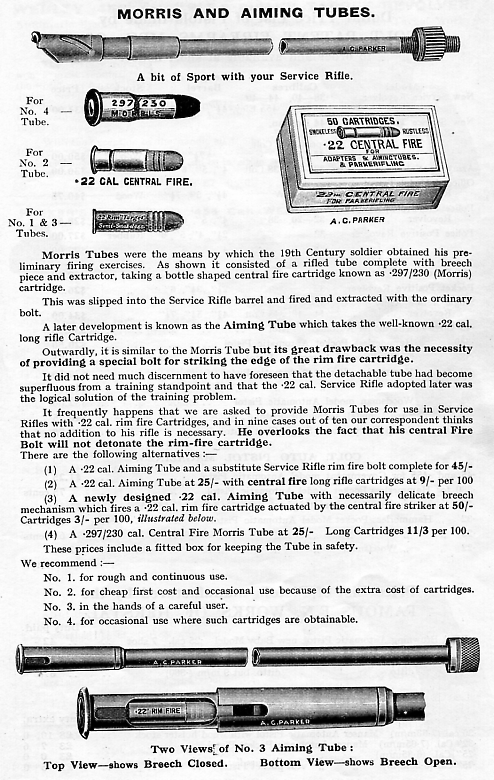
Notes on the MORRIS SYSTEM - from THE CITIZEN RIFLEMAN - 1906 - by E.J.D. Newitt
REDUCING DEVICES FOR ENABLING
THE USE OF LOW- POWER CARTRIDGES IN MILITARY RIFLES
"Innumerable attempts, attended with more or less success, have been made to
fire low-power cartridges from high-power rifles, but up to the present no device
is yet obtainable which realises the minimum in the matter of power and cost,
nor the maximum of accuracy. Reduction is accomplished in two ways : By reducing the calibre by the insertion of a smaller calibre barrel inside, the other,
and by reducing the charge, the calibre remaining the same. The Morris aiming
tube is an example of the former method. It has been extensively used for the
past quarter of a century in guns, rifles, and artillery. A rifled barrel of
.23 calibre, with a breech of .297 calibre, is inserted in the rifle from the
breech end and secured by a washer and nut screwed upon the end projecting from
the muzzle.
The 297.230, or Morris cartridge, is made of two powers, the long having a charge
of 5 grains of gunpowder or its equivalent in nitro explosive, and a bullet
weighing 38 grains—the short having 3 grains of powder and a bullet of
the same weight, both with central ignition. The former cost about £1,
and the latter £1:2s:6d ( £1.175)per thousand.
The energy generated by these cartridges is considerable, and in point of accuracy
they leave room for improvement. The exterior dimensions of the tube are limited
by the calibre of the barrel in which it is used. In the case of the British
Service weapon this is .303. The calibre of tube being .23 it cannot exceed
.0365 in.
thickness, and must therefore be very delicately handled. Where a large amount
of shooting is done from a few tubes, as will usually be the case, tendency
to lead and foul necessitates frequent wiping out. Thorough cleaning at the
close of shooting is best done with the tube in the rifle, but it must be frequently
removed to allow of the rifle's own barrel and chamber being cleaned. The use
of any reduced cartridges usually requires an alteration of the rifle sights,
which, being normally attached to compensate the jump of the barrel caused by the full-power charge,
require readjustment when the jump is altered by smaller charges. The adoption
of a backsight permitting lateral adjustment, the issue of which for all rifles
used in the British service has been officially announced, will minimise the
difficulty of readjusting the tube after removal, to shoot accurately to the
sights, so far as lateral deviation is concerned, but a higher foresight may
still be required.
As its name implies, the Morris aiming tube is designed to test the accuracy
of the user's aim whilst receiving instruction with the Service rifle. This
it accomplishes within its own limit of accuracy, and as an auxiliary to the
Service rifle it is invaluable. Considered solely as a rifle for Club purposes
it involves the purchase of an expensive rifle, comparatively expensive ammunition,
of insufficient accuracy. On the other hand it possesses the advantage of enabling
practice with the war weapon at short ranges, and by removing the tube the rifle
may be used with its full charge."
With the demise of the Morris cartridge, aiming tubes were introduced in .22 Rimfire calibre for the .303inch calibre centre-fire Service rifles. The equipment, housed in its wooden box, consisted of the tube, with its chamber and extraction sleeve attached, a bolt fitted with a modified bolt-head and a cleaning rod with .22 jag. See also pages for the Long-Lee .22RF conversion and the SMLE Mk.III* fitted with an aiming tube.

The bolt has been removed from its resting place at the left hand end of the box
Image courtesy of the Trustees of the Imperial War Museum - London
An unusual design for adapting a rifle for the firing of miniature calibre rimfire ammunition was patented by one Richard Wake in April of 1903.
The device enabled .22 rimfire cartridges to be used in place of the .297/.230" Morris ammunition.
Improvements in the Breech Mechanism of Rifles and other Guns for the Adaptation of Miniature Ammunition.
Abstract

Wake brought his invention to the notice of the military authorities, who evidently held significant interest in the design; indeed sufficient to approve it for adoption into service.
The abstracts of the Proceedings for the Ordnance Council of March 1905 reported the adoption, and correspondence with Wake relating to payment for the design and a request for two rifles fitted with his mechanism to be supplied to him free-of-charge.
Wake was offered half the initial offer of one thousand pounds, which he had refused, and was afforded an alternative of £500 down and a Royalty of one shilling and sixpence for each bolt manufactured.

Wake again refused the second offer, but accepted a down payment of £1,000 with reduced ongoing Royalties of one shilling per bolt produced.
However, in July 1906 the arrangement became contentious, with the authority deciding that the eventual usage of a bolt system did not fall within that of Wake's patent, and any subsequent royalties were not to be paid. Richard Wake's protests appear to have fallen on deaf ears.

Seven months later Wake applied for a further associated but modified patent, in January of 1907.
Nothing further has been found by us relating to these designs, and we have yet to discover any of the rifles that are presumed to have been constructed using Wake's system.
The latter patent is replicated below.
Improvements in the Breech Mechanism of Rifles and other Guns for the Adaptation of Miniature Ammunition.
Abstract

A little known aspect of Morris's inventiveness was a very early patent application he made for the design of a magazine that could be fitted to such as a Lee-Enfield rifle to enable magazine fire using miniature calibre cartridges. His design preceded that of the Hiscock-Parker magazine by more than twenty years, and indeed may well have provided the inspiration for Hiscock's ongoing patents.
Morris's patent no. 16,938 of 23rd. October 1890
Illustrated below are the chamber and extractor section of the shorter Morris Tube from an "MT" designated Martini-Metford Carbine.
It is seldom that a Morris Tube has any indication of where it was manufactured. Those tubes carrying an inspection mark of a Crown over "M" were indicated by Ian Skennerton's latest "Broad Arrow" reference book as being made by the Morris Sighting & Aiming Tube Co., but where else?
Does an Enfield inspection mark indicate a R.S.A.F. product - or only that it passed through there for inspection? That has been presumed to be the case, but is not certain. Were any/many of these tubes also supplied to the military by the Parker companies, who certainly sold significant numbers of them to Volunteer units and civilian clubs and their members? But were A.G.Parker perhaps initially just marketing Morris Company products, although later manufacturing their own in conjunction with the .22RF Aiming Tubes and rifled sleeves for their Parkerifling bore restoration system?
Issued Morris tubes were supposed to have been marked for the military in accordance with instructions for Rifle & Carbine markings, particularly with reference to unit and anny rack marks that may have been required to be stamped on those arms or their butt-disks.
On the basis that it may have been a rare manufacturer's mark, we hoped to discover the significance of the stamp to the left of the VR proof mark below, and that a reader could possibly come up with an answer.
The last image of the five below shows it in detail.
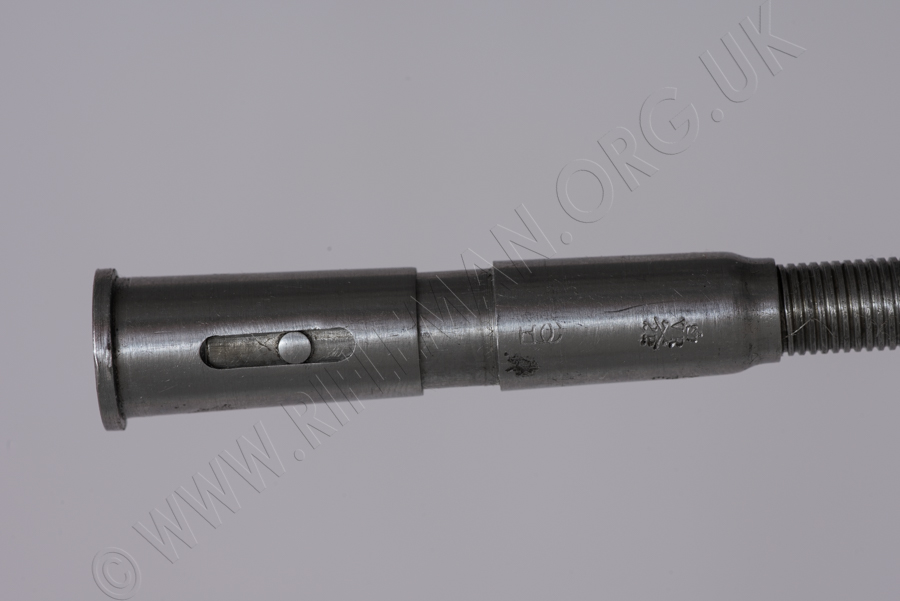
The "Crow's Foot" and Enfield inspection mark.
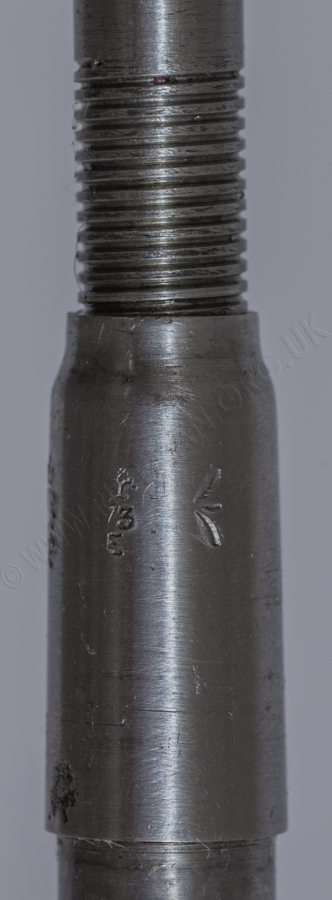
The military second proof mark, either London or Birmingham; to be confirmed one way or the other due to the indistinct crown.
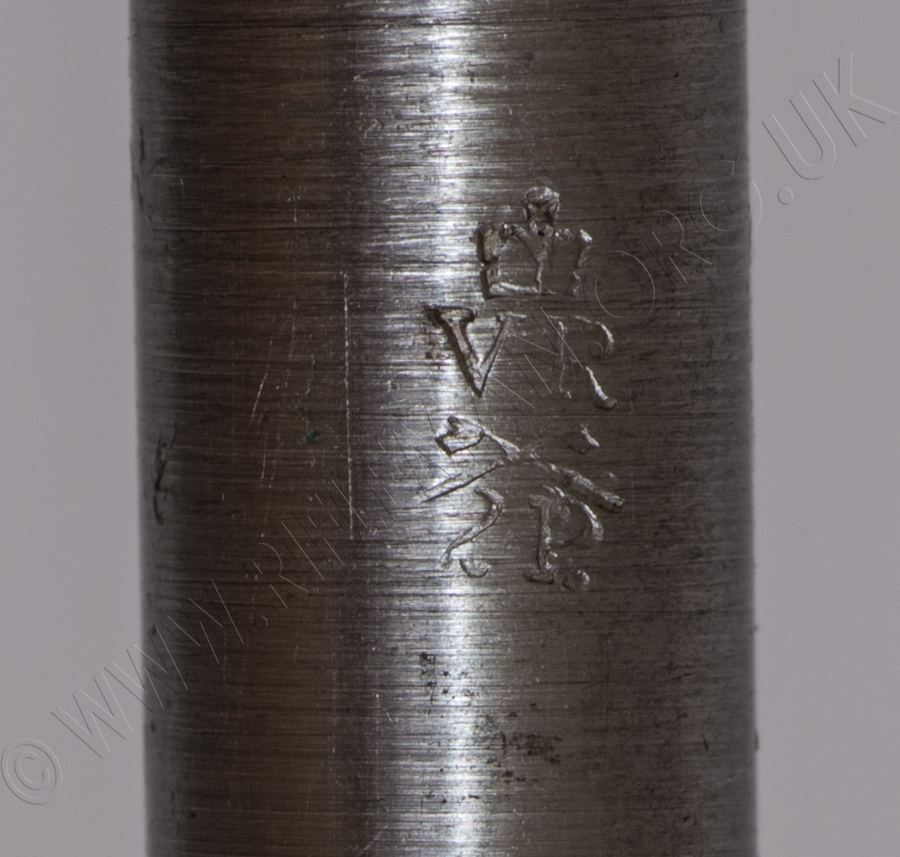
The monogrammed mark was presumed to end with "O" and "C",
but the first letter, which would initially be viewed as an "E", was thought to be uncertain, as the mid bar of the E is not a clean line.
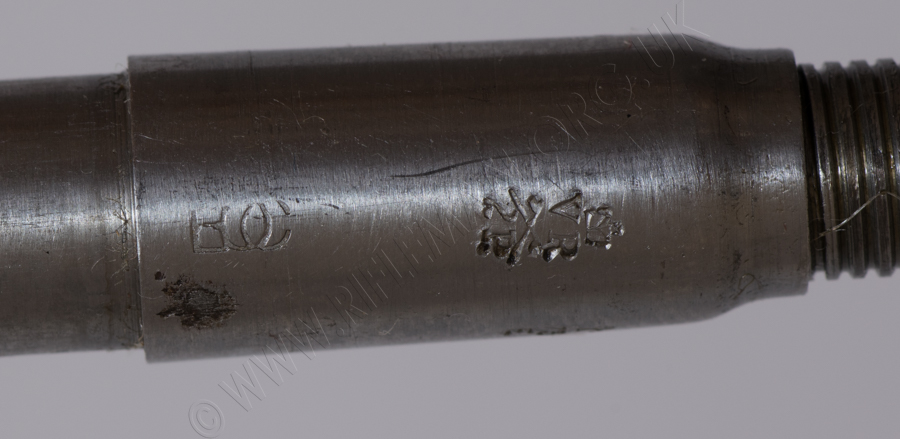
The stamping on the curved surface sadly lost the tops of the characters,
but we hoped it may be recognised by someone.
It could, we supposed, have been either a manufacturer's or unit's mark.
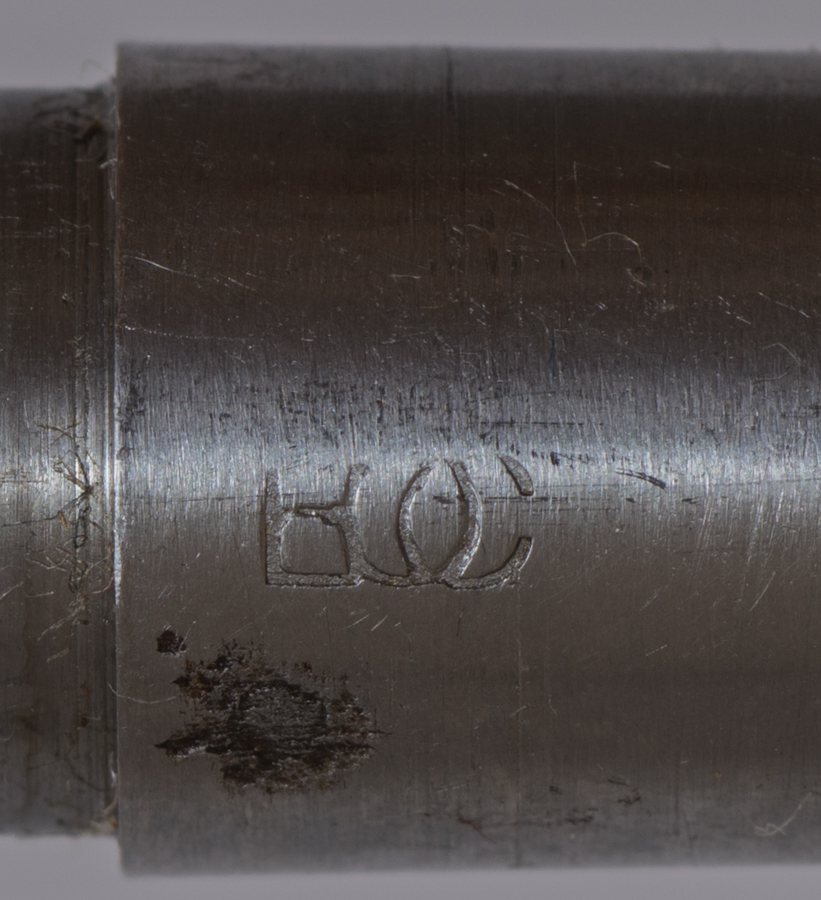
The extensive knowledge of manufacturers' markings on ammunition of a rather greater size than that with which most of us are familiar, a reader kindly advised that the monogramme is almost certainly that of the Elswick Ordnance Company of Newcastle-upon-Tyne - eventually part of the Armstrong group.
Grace's Guide reported that ........
" In 1859 William Armstrong was appointed government engineer for rifled ordnance, and superintendent of the royal gun factory at Woolwich, but the factory was unable to produce the Armstrong design of guns so, whilst it was being reconstructed, the Elswick Ordnance Factory was established alongside the Elswick engine works, exclusively to supply the government with Armstrong guns."
Around four years later, the EOC merged with what was by then Sir W. G. Armstrong and Company. Their Morris Tubes were somewhat at the opposite end of the size-range of rifled barrels leaving the EOC factory!
________________
If you are aware of any other manufacturer-marked Morris Tubes
we would be grateful to know of them.
Or indeed, if you can identify this mark found on an SMLE Morris Tube. The logo is akin to a Siamese numeral character, but not precisely so. The Tube is also marked "MORRIS PATENT" over "PRIVATE SALES".
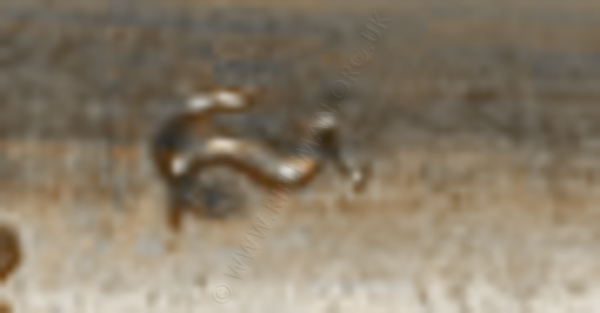
SEE ALSO
The Morris and .22RF Aiming Tubes ....- .... the Morris sight adaptor ......
The German K98 .22RF conversion unit ...-....The ".303 cum .22" conveyor system
plus - The Williams Floating Chamber - as applied to the Colt 1911 semi-automatic pistol
See also other Sub-calibre devices & systems including Parker-Hale revolver adaptations,
plus Sub-target devices
and for some unusual non-training Enfield rifle adaptations, see: Enfield Service rifle accessories and adaptations
View also Miniature Calibre Ammunition
For some unusual non-training Enfield rifle adaptations, see:
Enfield Service rifle accessories and adaptations
Read other Historical notes, articles and extracts relating to miniature calibre Training and Target Rifles
See also: a: Chronology of Enfield genre Training Rifles, Adapters & Cartridges